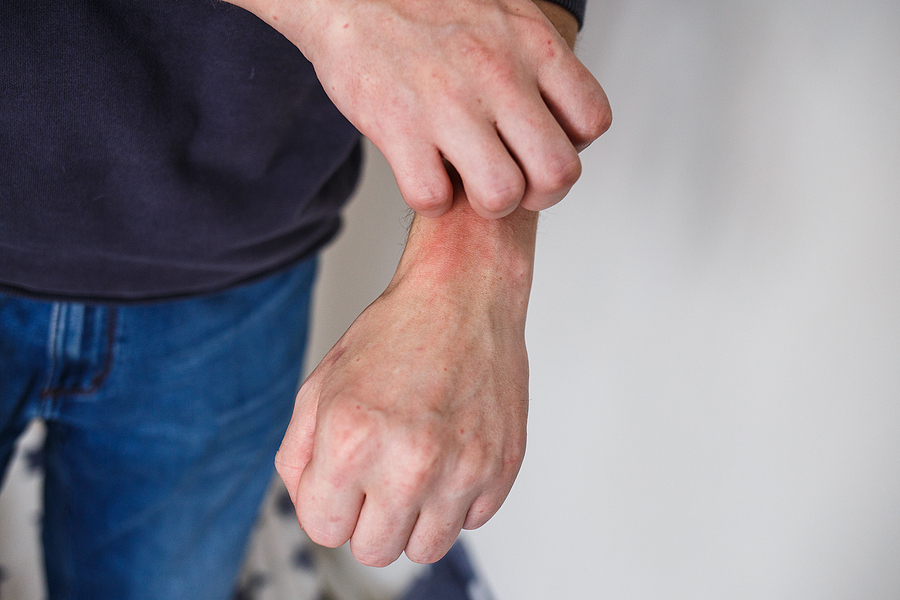
A nagging tickle in your throat has you coughing nonstop for hours and keeps you up all night. No matter how much you cough, you can’t seem to clear your throat. You’ve coughed so much your throat stings. Coughs may … Continue reading
READ MORE
Coming from personal experience, atopic dermatitis is one of the most frustrating conditions people face. Also known as eczema, which is a broad term for inflammation of the skin, so many things can trigger the inflammation, itching, and dry skin. It’s a chronic disease with no cure, but treatments help ease the itching and irritation.
The problem with this skin condition is that finding your triggers can take time and patience. Stress, environmental factors, products found in soaps, lotions, and cosmetics, pets, and many other things can trigger eczema symptoms. While the condition often appears in childhood, it affects people of all ages. Knowing the symptoms, triggers, and best treatments is essential for avoiding discomfort.
The Different Symptoms
The symptoms you experience may not be identical to what others experience. The severity also varies. The four most common symptoms are:
In addition to those common symptoms, some people experience skin that becomes darker or lighter in appearance, depending on your natural skin tone. The area affected also varies. In infants and toddlers, the face, joints, and scalp are the prominent areas where rashes develop. After the age of two through puberty, the ankles, elbows, knees, and necks are prevalent.
For teens and adults, eczema also appears on the ankles, feet, hands, and skin surrounding the eyes. Because the inflammation is close to the eyes, it’s also common to find the eyelid and eye white becoming red and inflamed. Pink eye may occur. Due to the damaged skin layers, scratching the areas can increase the risk of a bacterial infection setting in.
Eczema’s Many Triggers
Nine out of 10 people find their atopic dermatitis starts before the age of five. It’s extremely common and about 10% of infants and younger children have it. About 66% of those children continue to have flare-ups as adults. The frustrating part is that most people have several triggers, and it can tie closely to contact dermatitis where contact with an allergen triggers the flare-ups.
If there’s a family history of atopic dermatitis, it does increase the risk of having it. Researchers also found that there is a protein within your body that helps with skin health. If you don’t have healthy levels of that protein due to your genetic makeup, your skin’s barrier is weaker, which increases the risk of dry skin. Dry skin makes it easier for environmental factors to penetrate the top skin layer and cause atopic dermatitis.
Another cause is an immune system that doesn’t function properly. If you have an overactive immune system, it attacks healthy cells thinking they’re invaders. This can trigger inflammation in the skin cells that leads to atopic dermatitis.
You also have environmental factors that dry out the skin. They include the use of skin care products that contain ingredients that dry out the skin, such as heavy fragrances and alcohol. Air pollution impacts the skin’s protective barrier. So does smoking or exposure to tobacco smoke.
Stress is another issue. When you experience excessive stress, it can increase inflammation within the body. That can increase the chance of eczema flaring up. It’s impossible to avoid all stress, but learning to lower the cortisol response through meditation, relaxation techniques, and exercise all helps.
Did you know that menopause can trigger atopic dermatitis flare-ups? The declining estrogen levels impact the skin’s health. As your skin becomes drier and less resilient, eczema flare-ups are possible. It happens more in women who already experience eczema.
The Most Common Treatments
Once tests determine you have atopic dermatitis, what are the best treatment options? It depends on the triggering factors, but these are the options.
A skincare routine may help. This includes using a skin cleanser that’s hypoallergenic and avoids fragrances, parabens, and other potential irritants. Applying a moisturizer designed to restore the skin barrier, such as a hyaluronic cream, is important after patting the skin dry. For eczema on areas like the elbow, knees, or neck, applying the moisturizer while the skin is wet and then patting dry or allowing the skin to air dry traps water the skin absorbed during a bath or shower.
Oral corticosteroids are one option, but they are not meant for long-term use due to possible side effects like glaucoma or slowed healing. Topical corticosteroid creams are used more often instead of the oral medications. There are still risks with topical creams, however, such as skin discoloration and thinning skin. Both must be used as directed to avoid overuse.
If your skin becomes infected, antibiotics or antifungal medications may be required. It will end the infection and help ease the discomfort and itching. Those medications may be oral or topical.
Biologic injections are helpful in some cases. They work by blocking the body’s immune function, which helps control flare-ups. There are also oral medications like JAK inhibitors that also work on reducing the immune response.
For severe cases, doctors may recommend light therapy. Ultraviolet light waves are used to treat the inflammation. This treatment is more likely if the eczema is severe and not responding to other treatments.
Other treatments for severe atopic dermatitis are phosphodiesterase-4 inhibitor creams that are applied to the skin. These anti-inflammatory creams are also used for psoriasis.
Finally, there is a newer FDA-approved injection known as dupilumab that is used when other treatments don’t help. It stops the immune system from triggering an inflammatory response. It’s not recommended for people who also have asthma.
Take the First Step
Effective treatments are available. While they won’t cure atopic dermatitis, they can help ease the symptoms. You must take the first step, book an appointment with Premium Allergy.
In the initial exam, a doctor will examine your skin, ask questions about your lifestyle and the products you use on your skin, and gather as much information as possible. Blood tests and a skin biopsy may be ordered to rule out other conditions or possible causes of the rash.
Allergy skin tests can help determine if specific ingredients are causing your skin’s inflammation. Mold, pet dander, certain foods, fabrics like polyester, metals, chemicals, and fragrances may cause your flare-ups, and it’s important to pinpoint the exact causes so that you know to avoid them.
In my family, multiple generations have allergies to nickel and quaternium-15. As polyquaternium is found in hair products, lotions, cleaning products, shaving creams and gels, and body washes, reading labels is important so that we avoid that ingredient. It takes a test with an allergy expert to find potential triggers and learn the best ways to reduce skin inflammation through avoidance. Premium Allergy specializes in allergy testing and effective treatments.